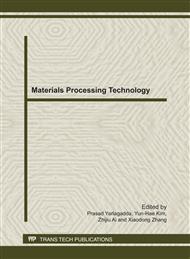p.650
p.655
p.660
p.665
p.670
p.674
p.678
p.682
p.686
Failure Analysis of a Welded Aluminum Alloy Component in High-Speed Train
Abstract:
In this paper, a failure analysis is made to a welded aluminum alloy component of the equipment by module below the high-speed train. Making force analysis to the welded components by finite element, microscopic morphology observation and element distribution measurement of the fracture surface are done by the scanning electron microscopy and spectroscopy .It is determined that the main reason of fracture of welded components was that stress concentration exist in the working conditions, and the weld toe is the most severe stress concentration region. The stress concentration causes the fatigue microcrack, and under the action of repeated external force crack propagates and then crack. Lacking of penetration sites is under tensile residual stress, the crack propagation speed, and soon to instability and then broken.
Info:
Periodical:
Pages:
670-673
Citation:
Online since:
September 2011
Authors:
Keywords:
Price:
Сopyright:
© 2011 Trans Tech Publications Ltd. All Rights Reserved
Share:
Citation:


